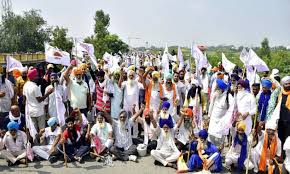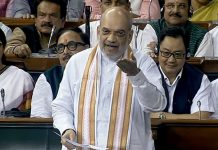Amidst the ongoing crisis in the farming sector, it is being felt that the efforts by the Modi government leave much to be desired. Unless the centre intervenes by way of acceding to their demands, farmers’ protests are likely to continue. A report by Raju Wiiliam

Since a year-long farmers protest on the borders of the national capital Delhi in 2020-21 and withdrawal of the three central farm laws by the BJP-led Modi government at the Centre, the second leg of their protest named Dilli Chalo since February 2024 shows no sign of ending. This time, their allegation is that the central government has backed out from the promises made to them when their previous protest was called off.
There have since been several rounds of talks between the leaders of the farmer organizations and the central government representatives, but no headway could be made so far. The main stumbling block in this entire solution seeking exercise is the farmers’ insistence on staging their protest again on the threshold of Delhi.
Unlike the previous protest, the difference this time is that the BJP government in the state of Haryana stopped their movement to Delhi on the national highway by putting up police-manned concrete barricades at its border with Punjab. Adamant on marching towards Delhi, a large number of protesters have since made the Punjab territory a venue of their temporary sit-in.
Due to this, the flow of traffic has severely been hampered for months together creating law and order problems and difficulties for all sections of people, especially for those living in the areas in Punjab and Haryana, close to their state border. The matter reached the Punjab and Haryana High Court and the Supreme Court of India seeking lifting of the curbs put up by the Haryana government to facilitate free flow of traffic.
As of now, the matter is under judicial consideration.
Even as the Supreme Court said this early September that matter should not be politicized, yet in the politically charged election year – national election 2024 and coming state elections in Haryana in October 2024 – the ongoing farmers’ protest holds electoral value for the political stakeholders in both states. “All parties are playing politics on the genuine issues of the farmers,” remarked Patiala-based eminent economist Prof. Ranjit Singh Ghuman.
Politics apart, it needs to be explored and understood as to what makes farmers sustain their protest of such long durations enduring trying weather conditions. The chilling winter in 2020-21 and scorching heat this summer has failed to deter them despite alleged high-handed measures adopted by the respective governments at the state and central levels. After resumption of the second round of their protest, it has become pertinent to look at peculiar traits of their collective character which have made them stay put in the face of the governments’ might?
In the historical perspective, human history is basically of struggles for survival and growth. The farmers and peasantry at large have brought about impactful changes through many violent and non-violent revolutions in the world and the Indian peasants are not exception to it. The role of Punjabi farmers and peasantry in pre and post independent India history is a witness of its contribution in the economy of the state and the nation building process but they remained neglected on all counts.
According to Prof. Jagrup Singh Sekhon, the former Head, Department of Political Science, Guru Nanak Dev University, Amritsar, the neo-liberal policies of the governments further marginalised them and made them vulnerable to the national and global giants to the extent never seen before. “In the contemporary period, they are facing a structural and survival crisis which is forcing them to get united and fight to assertively establish their relevance,” he pointed out.
Tracing the ideological base that sustains their long-drawn protests, one finds it is their historically shaped instinct for survival in the worst conditions. The history is full of instances of their fight against the rulers who they perceived as suppressive. In this context, the Gaddar movement and Pagri Sambhal Jatta during the country’s freedom struggle could be immediately quoted. And long before, they bore the brunt of frequent foreign invasions. All this steeled their nerves and inculcated a spirit of nationalism.
As Prof. Ghuman put it, this instinct of survival got activated when Punjab farmers thought the three farm laws would snatch their lands thereby posing a serious threat to their survival. This happened at a time when the farming was already reeling under a serious economic crisis. Its pinch was also felt by other stakeholders, especially the farm labourers.
This crisis has taken a heavy toll on life. Reportedly, more than 16,000 suicides by debt-ridden farmers and farm labourers took place till 2017, according to a study conducted by three universities in the state. This threatening number must have increased by now in the absence of measures needed to stop this, he added.
The Punjabi farmers, who are predominantly Sikhs draw their spirit of courage and sacrifice seeking justice for their cause from their religious philosophy which in essence is liberal in thought and action. Any attack on their religious identity would make them all the more determined to sustain their fight. They may be loud in speech yet would remain peaceful despite attempts of de-focussing their protests in the public perception.
Prof. Ghuman refers to this element of religious faith while tracing the roots of their unrelenting spirit behind these protests. After a sustained protest leading to withdrawal of three farm laws, their undaunting spirit, shaped by their faith and history of their community’s struggles, got boosted amidst a general perception about the Modi government being politically invincible.
Amidst the ongoing crisis in the farming sector, it is being felt that the efforts by the central government, which holds the main responsibility of diffusing it, leave much to be desired. The perception has gained ground that it lacks the will, which is why the farmers’ protest has become a sort of political football. On its part, the state government must do its bit on the economic front. The situation calls for setting up a price stabilization fund to provide financial cushion in case of fluctuations in the prices of crops.
Their major demands are legal status to MSP on all crops and debt waiver. A recent finding by National Sample Survey Organisation (NASSO) has shown an average farmer household is under debt of Rs. 2.98 lakh.
Punjab is in the throes of a vicious wheat-paddy cycle and immediately needs a diversification plan supported with adequate funds allocation by the state and the national governments. Several parts of the state are in a dark zone with the water table receding rapidly. The contamination of groundwater is a consequent serious health hazard for people in general.
The seriousness of the crisis calls for immediate central government intervention by way of acceding to farmers’ demands. Until this happens, such protests are likely to continue. “Putting it more correctly, I would say it is the central government’s cold and callous attitude which has allowed their protests to drag on. The BJP-led National Democratic Alliance government at the Centre will be committing a mistake if it underestimates the farmers’ grit and determination,” summed up Bubby Badal, a kinnow grower and a ruling party politician from the Malwa belt of the state.











